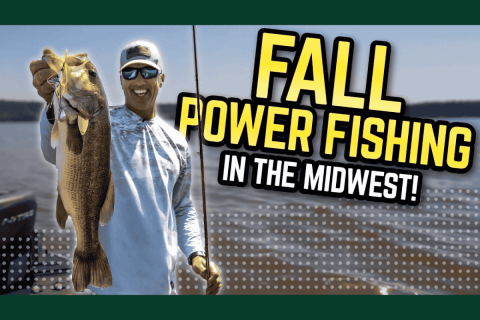
Fall Power Fishing in the Midwest with Edwin Evers
Cooler days, open water, and hungry bass.
When fall arrives across the Midwest, bass start feeding hard before winter sets in. Bass Pro Shops Pro Staff angler Edwin Evers shares his top three power fishing presentations for catching big bass during this seasonal transition. Whether you’re fishing local lakes or sprawling reservoirs, Edwin’s approach simplifies the process with proven baits and techniques.
Meet the Expert: Edwin Evers
Edwin Evers is one of the most decorated anglers in professional bass fishing history. Known for his relentless drive and analytical approach, Evers brings decades of experience fishing Midwest waters. As a Bass Pro Shops Pro Staff member, he focuses on teaching anglers how to adapt to seasonal changes and make confident lure choices that produce consistent results.
The Advantage of Fall Fishing
While most anglers turn their attention to hunting or football, the lakes get quieter—and that’s when the bite gets better. Cooling water pushes bass shallow, and baitfish like shad move into the creeks. Fewer boats and more active fish make fall one of the best times to catch big bass in the Midwest.
Edwin’s Top 3 Fall Power Fishing Techniques
1) Topwater Walking Baits
Few things in fishing beat a big topwater explosion. Evers prefers a walking-style bait such as the Berkley J Walker in bone color.
How to fish it:
- Target flat banks and shallow points where shad gather.
- Use braid line for better hooksets and easier bait control.
- Choose a 6’9” medium-action rod for quick downward twitches.
- A high-speed reel (8.3:1) helps take up slack and keeps your rhythm tight.
“You don’t need clouds to catch fish on topwater in the fall,” Edwin says. “They’re feeding up on shad, and they’ll come up for it even under bluebird skies.”
2) Spinnerbaits for Windy Conditions
When wind stirs up the surface or topwater becomes less effective, it’s time to reach for a spinnerbait. The flash and thump of the blades mimic baitfish perfectly.
Setup tips:
- Use a ½-ounce spinnerbait with smaller blades to match the size of fall shad.
- Choose translucent skirts for clear water and white or chartreuse for stained conditions.
- Fish along laydowns, docks, or rocky banks, and let the wind help you cover water.
- Rig on 20-lb fluorocarbon with a 7’1” medium-heavy rod and a 6.8:1 reel for control.
Evers likes spinnerbaits because they show bass something different than a crankbait. He explains that many anglers overlook this lure in favor of squarebills, giving spinnerbaits an edge on pressured waters.
3) Big Worms for Big Bass
As temperatures drop, larger bass often want one big, easy meal. For Evers, that means a 10-inch Berkley Power Worm in Blue Fleck.
How to fish it:
- Rig on a 5/0 hook with a 3/16 to ¼-ounce weight depending on depth.
- Use 14–20 lb fluorocarbon depending on cover.
- Cast to brush piles, dock edges, or stumps in 5 to 15 feet of water.
- Keep movements subtle—most bites happen as the worm falls or just as you lift it.
The long profile of the worm imitates gizzard shad, one of the bass’s favorite fall meals. It’s a slow, methodical approach that catches the biggest fish in the school.
Key Fall Fishing Takeaways
- Fall means less pressure and more active bass.
- Follow shad migration to flats, coves, and creek mouths.
- Adjust your presentation to match water clarity and weather.
- Always keep a big worm tied on for slower, post-front conditions.
- Confidence in your lure and cadence is the key to success.
FAQs
What color topwater bait works best in Midwest lakes?
Bone or white colors perform well across most conditions. They imitate shad and stay visible in both clear and stained water.
When should I switch from topwater to spinnerbait?
Move to a spinnerbait when wind roughens the surface or when bass stop committing to surface strikes.
Why downsize spinnerbait blades in fall?
Because shad are smaller this time of year, smaller blades better match the hatch and trigger more bites.
How do I know when to use the big worm?
When fish stop chasing fast-moving baits, slow down and drag a large worm through brush or docks.
What rod setup is best for a topwater walking bait?
A 6’8”–6’9” medium-action rod with braid and a high-speed reel allows better control and more accurate casts.
- 173 views

